Basal Cell Skin Cancer: Resource Guide
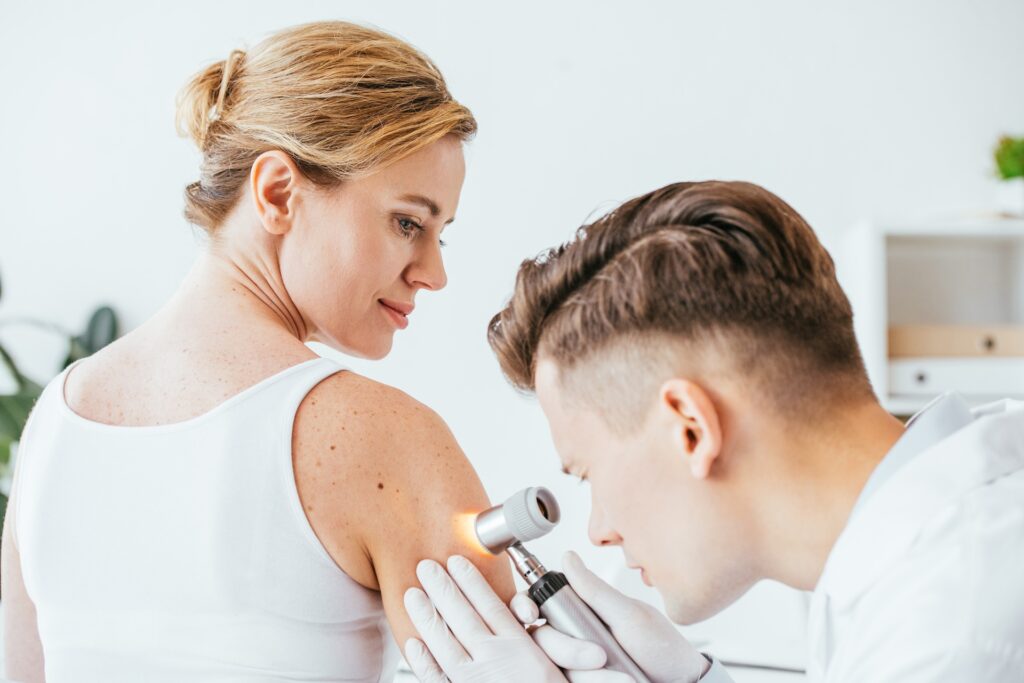
Basal cell skin cancer is the most common type of skin cancer, typically developing in the basal cells, which are located in the deepest layer of the skin’s epidermis. This non-melanoma skin cancer is usually slow-growing and rarely spreads to other parts of the body, making it highly treatable when detected early. Basal cell skin cancer often appears as a small, painless bump or lesion on the skin, which may bleed or develop a scab, but it can also present in various forms, such as nodules, sores, or red patches. While it tends to occur most frequently on areas of the body exposed to the sun, basal cell skin cancer can also develop on less-exposed skin. Regular skin examinations and prompt medical attention are essential to effectively manage and treat basal cell skin cancer.
How to Spot Basal Cell Skin Cancer?
Detecting basal cell skin cancer in its early stages is crucial for successful treatment. Keep an eye out for any unusual changes on your skin, including the appearance of small, shiny, pearly bumps or pinkish patches that don’t heal, crust over, or bleed easily. If you notice any of these signs, especially on sun-exposed areas like your face, neck, ears, or scalp, it’s essential to consult a dermatologist promptly. Regular self-examinations and annual skin checks by a dermatologist are key in identifying basal cell skin cancer early, increasing the likelihood of effective intervention and a positive outcome.


Basal Cell Skin Cancer Risk Factors and Causes
Risk factors for basal cell skin cancer include prolonged UV radiation exposure, fair skin, advancing age (typically over 50), being male, a family history of skin cancer, genetic conditions, and a weakened immune system due to medication or medical conditions. Those with these risk factors should take precautions and have regular skin evaluations to detect and manage basal cell skin cancer early.
Signs and Symptoms of Basal Cell Skin Cancer
Basal cell skin cancer may manifest differently in its early and late stages. In the early stages, basal cell skin cancer often appears as small, shiny, pearly bumps or pinkish patches that may crust over, bleed easily, or not heal. As the cancer advances to its late stage, symptoms can become more pronounced and alarming. At this point, basal cell skin cancer may present as larger, ulcerated lesions with raised borders, and may even invade surrounding tissues, causing pain or bleeding. Recognizing and addressing basal cell skin cancer in its early stages is vital for successful treatment and minimizing potential disfigurement or complications. Regular skin examinations and dermatologist consultations are essential for prompt detection and intervention.
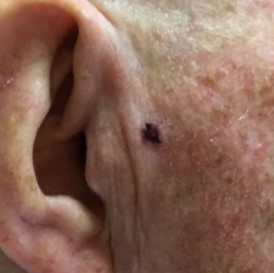
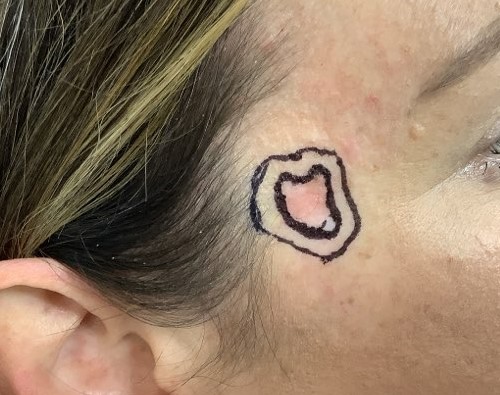
Different Types of Basal Cell Skin Cancer
Basal cell skin cancer presents in various common forms, including nodular basal cell skin cancer, superficial basal cell skin cancer, and infiltrative basal cell skin cancer. Nodular basal cell skin cancer appears as a raised, shiny bump, superficial basal cell skin cancer as scaly patches, and infiltrative basal cell skin cancer as lesions that grow deeper into the skin. Each type requires individualized treatment approaches, emphasizing the importance of early detection and proper diagnosis by a dermatologist.
Detection and Diagnosis of Basal Cell Skin Cancer
Detection and diagnosis of basal cell skin cancer involve a combination of visual examination and often, a biopsy. Dermatologists typically assess the skin for suspicious growths during routine check-ups, paying attention to their size, shape, color, and any changes over time. If a lesion appears concerning, a biopsy is performed, where a small sample of tissue is collected for laboratory analysis. This biopsy confirms the presence of basal cell skin cancer and helps determine the specific subtype. Early detection through regular skin checks and prompt diagnosis is essential for effective management and treatment of basal cell carcinoma.
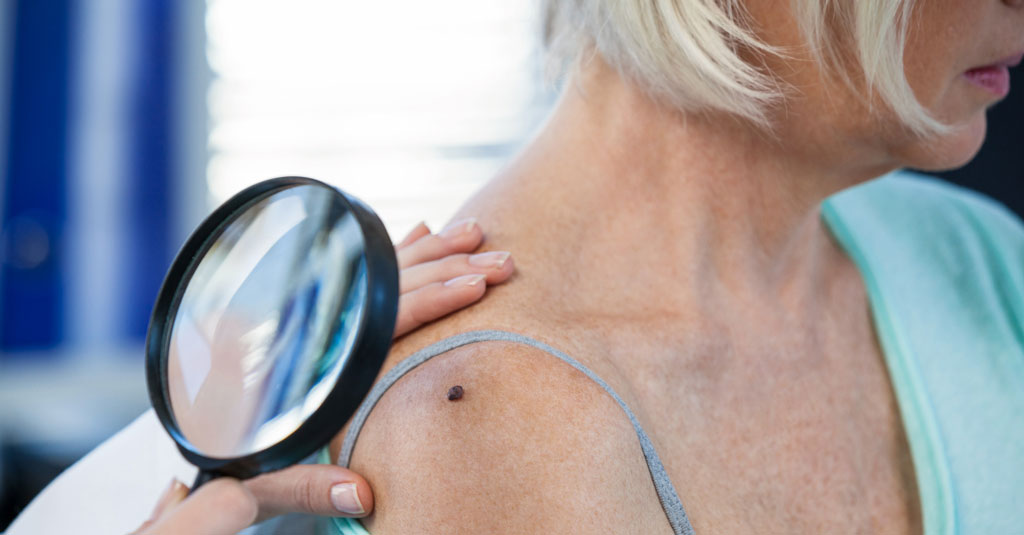
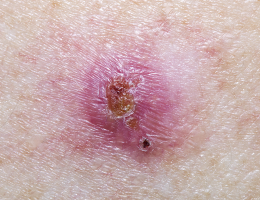
What are the Stages of Basal Cell Skin Cancer?
Basal cell skin cancer typically progresses through four stages, each indicating the extent of the cancer’s growth and potential for spread. In Stage 0, basal cell skin cancer is confined to the top layer of the skin and is considered non-invasive. At Stage I, the cancer has penetrated deeper layers but remains small. Stage II denotes larger tumors or those with aggressive features. In the advanced Stage III, basal cell skin cancer has spread to nearby tissues or structures like bone or cartilage. Fortunately, basal cell skin cancer rarely progresses to Stage IV, which signifies distant metastasis to other parts of the body. The stage at which basal cell skin cancer is diagnosed plays a crucial role in determining the appropriate treatment approach and prognosis, making early detection and intervention essential.
Basal Cell Skin Cancer Treatments and Side Effects
Treatment options for basal cell skin cancer are diverse and depend on factors like the cancer’s stage, size, and location. Common approaches include surgical excision, Mohs micrographic surgery, cryotherapy, and topical creams. A notable non-invasive option is Image-Guided SRT which is effective for early-stage basal cell skin cancer. It delivers precise radiation directly to the tumor site, sparing healthy tissue and minimizing scarring. Side effects of basal cell skin cancer treatments can include pain, scarring, infection, and changes in skin texture or color. However, Image-Guided SRT often results in fewer side effects and shorter recovery times compared to surgical methods, making it an appealing choice for eligible patients. It’s essential to consult with a dermatologist to determine the most suitable treatment based on individual circumstances and cancer characteristics.

- What to Expect When You’re Having Image-Guided Superficial Radiotherapy for Skin Cancer
- How Image-Guided SRT Works
- Image-Guided SRT Compared to Mohs Surgery
- What to Expect from a Dermatology Visit & Questions to Ask About Image-Guided SRT for Skin Cancer
- Questions to Consider After Your Skin Cancer Treatments

Prognosis, Recovery and Post Treatment Care of Basal Cell Skin Cancer
The prognosis for basal cell skin cancer is generally excellent, especially when detected and treated early. Recovery after successful treatment typically involves wound care to promote healing and minimize scarring, as well as diligent sun protection to prevent recurrence. Regular follow-up appointments with a dermatologist are crucial for monitoring and early detection of any potential basal cell skin cancer recurrence or new skin cancer development. It’s essential to continue practicing sun-safe habits, including wearing sunscreen, protective clothing, and avoiding excessive sun exposure, to reduce the risk of future skin cancers. Overall, with proper post-treatment care and ongoing vigilance, individuals can enjoy a favorable prognosis and maintain skin health.
Stay Up-to-Date with Basal Cell Skin Cancer, Treatments and Recovery with GentleCure
Discover a wealth of knowledge on basal cell skin cancer and the cutting-edge Image-Guided SRT treatment through our comprehensive resource page. Gain insights into the early detection, diagnosis, and staging of basal cell skin cancer, along with detailed information about the benefits and procedure of Image-Guided SRT. Our resource page provides a holistic understanding of basal cell skin cancer management, including post-treatment care and tips for maintaining healthy skin. Call us at 855-767-8680 to discuss treatment and where to find a dermatologist to help. Empower yourself with expert guidance and resources to make informed decisions about your skin health and explore the potential of Image-Guided SRT in your basal cell skin cancer journey.
Everyone Deserves a Surgery-Free Treatment Option
Participate in change. Do not let radiation oncologists limit your treatment options to protect their income. Sign a FREE petition to tell Medicare and health insurers that you expect them to CONTINUE COVERING an FDA-cleared, less invasive treatment option.